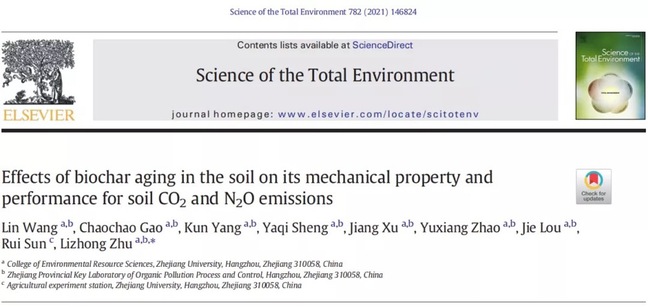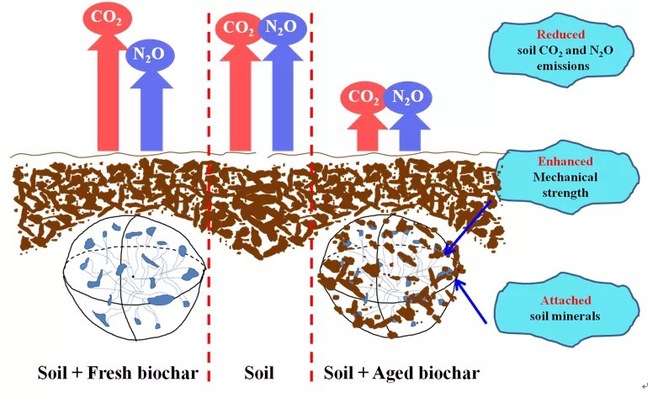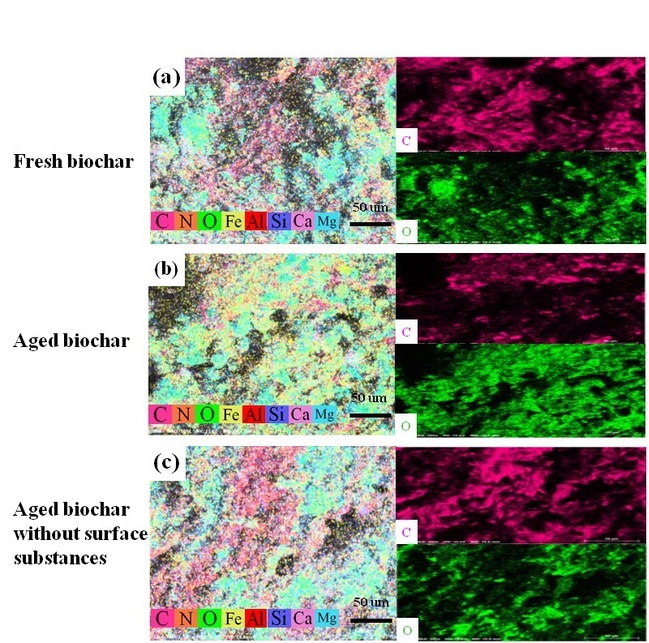Introduction
Global warming is an important issue facing society today. Biochar carbon storage in soils is a potential natural-based solution for carbon sequestration. In recent years, Lehmann and others have repeatedly introduced and recommended this technology in Nature. In response to the large-scale implementation potential and feasibility of soil-biochar carbon sequestration proposed by him, the team of Academician Zhu Lizhong has been committed to systematic researches (i.e. key influencing factors, macro-scale biochar application scenarios, the overall potential of biochar carbon sequestration in farmland soil in China), which provide scientific basis to maximize the potential of biochar carbon sequestration in soil environment to promote the realization of carbon neutrality. Recently, they have revealed the mystery of biochar earth armor. Today, let us take a look at the mystery of the earth armor. Can it promote carbon storage?



Figure 1 Scanning electron micrographs of fresh biochar and aged biochar
The fresh biochar exposed a wrinkled surface with cracks and channels (Figure 1a, Figure 1c and Figure 1e). In contrast, the aged biochar showed an observable covering on the surface (Figure 1b). In the image with large magnifications (500 times) (Figure 1f), the surface of aged biochar was observed to attach with a lot of fine particles, blocking the cracks and channels that were observed on the fresh biochar’s surface (Figure 1e). After the removal of the surface substances, both the fresh and aged biochar showed a surface with cracks and channels (Figure 1g and 1h).
Ⅱ

Figure 2 EDS images of the biochar’s surface elements
The SEM-EDS results further indicated that the contents of Si, Al, Fe, and O elements on the surface of aged biochar were significantly increased, as compared to those on fresh biochar which means that the aged biochar was attached with soil minerals (e.g., SiO2). Moreover, the surface contents of soil mineral elements (Si, Al, and Fe) on the aged biochar were decreased after scraping the surface substances.
Ⅲ

Figure 3 Characterization of physicochemical properties of biochar
(a) XRD pattern, (b) SSA, (c) FTIR spectra, and (d) Result of Oxidation experiment.
(“Aged biochar*” was abbreviated for “Aged biochar with surface removed”).
XRD results further supported the existence of certain minerals on the aged biochar. The surface area of the biochar after the field aging was significantly smaller than the fresh biochar (Figure 3b), consistent with the mineral accumulation of soil minerals on the surface of the biochar after the field aging, which blocked the cracks and channels (Figure1d, Figure 2 and Figure 3a). The discrepancy between the FTIR spectra of interior biochar and the surface substances indicated the high possibility of organo-mineral complexations, which had been widely reported. The oxidation test showed that the aged biochar with composite layer formed has a higher resistance to chemical oxidation than the fresh biochar. The chemical oxidation test indirectly proved that the soil minerals attached to the aged biochar can enhance the anti-chemical oxidation process of the biochar in the soil environment.
Ⅳ

Figure 4 Mechanical performance analysis
The results suggested the improvement of biochar particles’ mechanical strength after the field aging process, which would benefit the sequestration of particle internal structure and substances. The improvement of compressive strength of the aged biochar particles indicates that they might be able to withstand a higher mechanical pressure than the fresh biochar particles, leading to relative lower potential environmental risks, e.g., less fragmentation, less surface carbon loss, and more benefits for the microbial communities in the biochar particles.
Ⅴ

Figure 5 The impact of biochar on soil CO2 or N2O emissions
(“Aged biochar*” was abbreviated for “Aged biochar without surface substances”)
Fresh biochar had no significant impact on soil CO2 emissions, and significantly reduced soil accumulated N2O emissions; aged biochar further significantly reduced soil CO2 and N2O emissions (P<0.05); after scraping off the surface material of aged biochar, the soil CO2 emission reduction effect of aged biochar has disappeared while the soil N2O emission reduction effect was weakened. The results indicated that the surface material of the aged biochar (containing more organic-mineral complexes) played an important role in reducing soil CO2 and N2O emissions.
Conclusions
These results indicate that soil minerals could accumulate on the biochar during the field aging process, forming organo-mineral complexes, blocking the cracks and channels of the biochar, and improving its mechanical properties. The improved mechanical properties could inhibit the fragmentation of biochar particles, reducing the release of labile fractions from the biochar and the subsequent CO2 and N2O emissions. These findings also indicate that adjusting the mechanical properties of biochar particles to improve their physical stability before adding them into the soil, may be a potential way to better control the release of soil CO2 and N2O emissions.
本文内容来自ELSEVIER旗舰期刊Sci Total Environ第782卷发表的论文:Wang, L., Gao, CC., Yang, K., Sheng, YQ., Xu, J., Zhao, YX., Lou, J., Sun, R., Zhu, LZ., 2021. Effects of biochar aging in the soil on its mechanical property and performance for soil CO2 and N2O emissions, Sci Total Environ 782, 146824. DOI:
https://doi.org/10.1016/j.scitotenv.2021.146824












